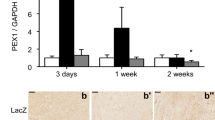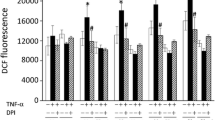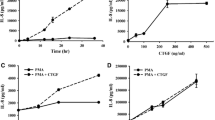Abstract
Matrix metalloproteinase 9 (MMP-9), a member of MMP family, is involved in many physiological processes, including cardiovascular disease (CVD). Tumor necrosis factor-α (TNF-α) is considered a cytokine with pleiotropic biological capabilities and leads to the process of CVD when TNF-α is abnormally released and stimulates MMP-9 expression and activation. In this study, we investigated the molecular mechanism of TNF-α-regulated MMP-9 expression. The experimental results confirm that TNF-α could upregulate MMP-9 expression in heart myoblast H9c2 cells of rat. To evaluate the MMP-9 regulation at transcriptional level, a DNA fragment of 2.2 kb (−2168/+18) of human mmp-9 promoter region was cloned and constructed in a vector of luciferase reporter gene. The 2.2-kb sequences were identified as having three candidate nuclear factor-κ B (NF-κB) binding sites: NF-κB I (−1418/−1409), NF-κB II (−626/−617), and NF-κB III (−353/−345). A series of reporter vectors with the mutated NF-κB sites of mmp-9 promoter sequences were constructed and transfected into H9c2 cells. The results show that the NF-κB II binding site (−626/−617) within the promoter region of mmp-9 plays a key role in upregulation of mmp-9 expression by TNF-α induction. In addition, we also first identified that the NF-κB I, similar to c-Rel, might be one of the NF-κB families to regulate mmp-9 expression.





Similar content being viewed by others
References
Nagase, H., & Woessner, J. F., Jr. (1999). Matrix metalloproteinases. The Journal of Biological Chemistry, 274, 21491–21494.
Cho, A., & Reidy, M. A. (2002). Matrix metalloproteinase-9 is necessary for the regulation of smooth muscle cell replication and migration after arterial injury. Circulation Research, 91, 845–851.
Gutierrez-Fernandez, A., Inada, M., Balbin, M., Fueyo, A., Pitiot, A. S., Astudillo, A., et al. (2007). Increased inflammation delays wound healing in mice deficient in collagenase-2 (MMP-8). The FASEB Journal, 21, 2580–2591.
Miller, M. C., Manning, H. B., Jain, A., Troeberg, L., Dudhia, J., Essex, D., et al. (2009). Membrane type 1 matrix metalloproteinase is a crucial promoter of synovial invasion in human rheumatoid arthritis. Arthritis and Rheumatism, 60, 686–697.
Schulz, R. (2007). Intracellular targets of matrix metalloproteinase-2 in cardiac disease: rationale and therapeutic approaches. Annual Review of Pharmacology and Toxicology, 47, 211–242.
Egeblad, M., & Werb, Z. (2002). New functions for the matrix metalloproteinases in cancer progression. Nature Reviews. Cancer, 2, 161–174.
Ray, A., Bal, B. S., & Ray, B. K. (2005). Transcriptional induction of matrix metalloproteinase-9 in the chondrocyte and synoviocyte cells is regulated via a novel mechanism: evidence for functional cooperation between serum amyloid A-activating factor-1 and AP-1. Journal of Immunology, 175, 4039–4048.
Kizaki, K., Ito, R., Okada, M., Yoshioka, K., Uchide, T., Temma, K., et al. (2006). Enhanced gene expression of myocardial matrix metalloproteinases 2 and 9 after acute treatment with doxorubicin in mice. Pharmacological Research, 53, 341–346.
Yoon, Y. W., Kwon, H. M., Hwang, K. C., Choi, E. Y., Hong, B. K., Kim, D., et al. (2005). Upstream regulation of matrix metalloproteinase by EMMPRIN; extracellular matrix metalloproteinase inducer in advanced atherosclerotic plaque. Atherosclerosis, 180, 37–44.
Pacher, P., Schulz, R., Liaudet, L., & Szabo, C. (2005). Nitrosative stress and pharmacological modulation of heart failure. Trends in Pharmacological Sciences, 26, 302–310.
Yong, V. W., Power, C., Forsyth, P., & Edwards, D. R. (2001). Metalloproteinases in biology and pathology of the nervous system. Nature Reviews. Neuroscience, 2, 502–511.
Liacini, A., Sylvester, J., Li, W. Q., & Zafarullah, M. (2005). Mithramycin downregulates proinflammatory cytokine-induced matrix metalloproteinase gene expression in articular chondrocytes. Arthritis Research & Therapy, 7, R777–R783.
Quiding-Jarbrink, M., Smith, D. A., & Bancroft, G. J. (2001). Production of matrix metalloproteinases in response to mycobacterial infection. Infection and Immunity, 69, 5661–5670.
Zhang, Y., McCluskey, K., Fujii, K., & Wahl, L. M. (1998). Differential regulation of monocyte matrix metalloproteinase and TIMP-1 production by TNF-alpha, granulocyte-macrophage CSF, and IL-1 beta through prostaglandin-dependent and -independent mechanisms. Journal of Immunology, 161, 3071–3076.
Deschamps, A. M., & Spinale, F. G. (2006). Pathways of matrix metalloproteinase induction in heart failure: bioactive molecules and transcriptional regulation. Cardiovascular Research, 69, 666–676.
Kawamura, N., Kubota, T., Kawano, S., Monden, Y., Feldman, A. M., Tsutsui, H., et al. (2005). Blockade of NF-kappaB improves cardiac function and survival without affecting inflammation in TNF-alpha-induced cardiomyopathy. Cardiovascular Research, 66, 520–529.
Lindsey, M. L. (2004). MMP induction and inhibition in myocardial infarction. Heart Failure Reviews, 9, 7–19.
Gum, R., Lengyel, E., Juarez, J., Chen, J. H., Sato, H., Seiki, M., et al. (1996). Stimulation of 92-kDa gelatinase B promoter activity by ras is mitogen-activated protein kinase kinase 1-independent and requires multiple transcription factor binding sites including closely spaced PEA3/ets and AP-1 sequences. The Journal of Biological Chemistry, 271, 10672–10680.
Sato, H., & Seiki, M. (1993). Regulatory mechanism of 92 kDa type IV collagenase gene expression which is associated with invasiveness of tumor cells. Oncogene, 8, 395–405.
Ogawa, K., Chen, F., Kuang, C., & Chen, Y. (2004). Suppression of matrix metalloproteinase-9 transcription by transforming growth factor-beta is mediated by a nuclear factor-kappaB site. The Biochemical Journal, 381, 413–422.
May, M. J., & Ghosh, S. (1997). Rel/NF-kappa B and I kappa B proteins: an overview. Seminars in Cancer Biology, 8, 63–73.
De Martin, R., Hoeth, M., Hofer-Warbinek, R., & Schmid, J. A. (2000). The transcription factor NF-kappa B and the regulation of vascular cell function. Arteriosclerosis, Thrombosis, and Vascular Biology, 20, E83–E88.
Barnes, P. J., & Adcock, I. M. (1997). NF-kappa B: a pivotal role in asthma and a new target for therapy. Trends in Pharmacological Sciences, 18, 46–50.
Vincenti, M. P., & Brinckerhoff, C. E. (2007). Signal transduction and cell-type specific regulation of matrix metalloproteinase gene expression: can MMPs be good for you? Journal of Cellular Physiology, 213, 355–364.
He, C. (1996). Molecular mechanism of transcriptional activation of human gelatinase B by proximal promoter. Cancer Letters, 106, 185–191.
Hemsley, A., Arnheim, N., Toney, M. D., Cortopassi, G., & Galas, D. J. (1989). A simple method for site-directed mutagenesis using the polymerase chain reaction. Nucleic Acids Research, 17, 6545–6551.
Kuan, T. C., Yang, T. H., Wen, C. H., Chen, M. Y., Lee, I. L., & Lin, C. S. (2011). Identifying the regulatory element for human angiotensin-converting enzyme 2 (ACE2) expression in human cardiofibroblasts. Peptides, 32, 1832–1839.
Liu, Y. C., Lin, W. Y., Jhang, Y. R., Huang, S. H., Wu, C. P., & Wu, H. T. (2011). Efficiency of DNA transfection of rat heart myoblast cells H9c2(2-1) by either polyethyleneimine or electroporation. Applied Biochemistry and Biotechnology, 164, 1172–1182.
Chang, C. C., Kuan, T. C., Hsieh, Y. Y., Ho, Y. J., Sun, Y. L., & Lin, C. S. (2011). Effects of diosgenin on myometrial matrix metalloproteinase-2 and -9 activity and expression in ovariectomized rats. International Journal of Biological Sciences, 7, 837–847.
Chen, C. L., Huang, S. K., Lin, J. L., Lai, L. P., Lai, S. C., Liu, C. W., et al. (2008). Upregulation of matrix metalloproteinase-9 and tissue inhibitors of metalloproteinases in rapid atrial pacing-induced atrial fibrillation. Journal of Molecular and Cellular Cardiology, 45, 742–753.
Jones, C. B., Sane, D. C., & Herrington, D. M. (2003). Matrix metalloproteinases: a review of their structure and role in acute coronary syndrome. Cardiovascular Research, 59, 812–823.
Nelson, A. R., Fingleton, B., Rothenberg, M. L., & Matrisian, L. M. (2000). Matrix metalloproteinases: biologic activity and clinical implications. Journal of Clinical Oncology, 18, 1135–1149.
Ye, S. (2000). Polymorphism in matrix metalloproteinase gene promoters: implication in regulation of gene expression and susceptibility of various diseases. Matrix Biology, 19, 623–629.
Kent, W. J., Sugnet, C. W., Furey, T. S., Roskin, K. M., Pringle, T. H., Zahler, A. M., et al. (2002). The human genome browser at UCSC. Genome Research, 12, 996–1006.
Clark, I. M., Swingler, T. E., Sampieri, C. L., & Edwards, D. R. (2008). The regulation of matrix metalloproteinases and their inhibitors. The International Journal of Biochemistry & Cell Biology, 40, 1362–1378.
Eberhardt, W., Huwiler, A., Beck, K. F., Walpen, S., & Pfeilschifter, J. (2000). Amplification of IL-1 beta-induced matrix metalloproteinase-9 expression by superoxide in rat glomerular mesangial cells is mediated by increased activities of NF-kappa B and activating protein-1 and involves activation of the mitogen-activated protein kinase pathways. Journal of Immunology, 165, 5788–5797.
Han, Y. P., Tuan, T. L., Hughes, M., Wu, H., & Garner, W. L. (2001). Transforming growth factor-beta - and tumor necrosis factor-alpha -mediated induction and proteolytic activation of MMP-9 in human skin. The Journal of Biological Chemistry, 276, 22341–22350.
Lungu, G., Covaleda, L., Mendes, O., Martini-Stoica, H., & Stoica, G. (2008). FGF-1-induced matrix metalloproteinase-9 expression in breast cancer cells is mediated by increased activities of NF-kappaB and activating protein-1. Molecular Carcinogenesis, 47, 424–435.
Moon, S. K., Cha, B. Y., & Kim, C. H. (2004). ERK1/2 mediates TNF-alpha-induced matrix metalloproteinase-9 expression in human vascular smooth muscle cells via the regulation of NF-kappaB and AP-1: involvement of the ras dependent pathway. Journal of Cellular Physiology, 198, 417–427.
Sato, T., Ito, A., Ogata, Y., Nagase, H., & Mori, Y. (1996). Tumor necrosis factor alpha (TNFalpha) induces pro-matrix metalloproteinase 9 production in human uterine cervical fibroblasts but interleukin 1alpha antagonizes the inductive effect of TNFalpha. FEBS Letters, 392, 175–178.
May, M. J., & Ghosh, S. (1998). Signal transduction through NF-kappa B. Immunology Today, 19, 80–88.
Brinckerhoff, C. E., & Matrisian, L. M. (2002). Matrix metalloproteinases: a tail of a frog that became a prince. Nature Reviews. Molecular Cell Biology, 3, 207–214.
Chakraborti, S., Mandal, M., Das, S., Mandal, A., & Chakraborti, T. (2003). Regulation of matrix metalloproteinases: an overview. Molecular and Cellular Biochemistry, 253, 269–285.
Acknowledgment
This work was supported by the grants of NSC 97-2313-B-415-005-MY3 from the National Science Council, Taiwan.
Author information
Authors and Affiliations
Corresponding author
Rights and permissions
About this article
Cite this article
Wu, H.T., Sie, S.S., Kuan, T.C. et al. Identifying the Regulative Role of NF-κB Binding Sites Within Promoter Region of Human Matrix Metalloproteinase 9 (mmp-9) by TNF-α Induction. Appl Biochem Biotechnol 169, 438–449 (2013). https://doi.org/10.1007/s12010-012-9958-3
Received:
Accepted:
Published:
Issue Date:
DOI: https://doi.org/10.1007/s12010-012-9958-3




